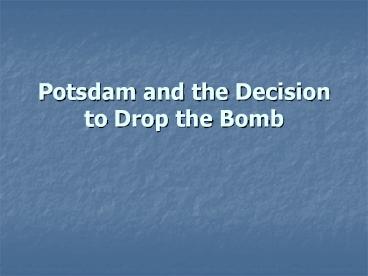Potsdam and the Decision to Drop the Bomb - PowerPoint PPT Presentation
1 / 25
Title:
Potsdam and the Decision to Drop the Bomb
Description:
Potsdam and the Decision to Drop the Bomb Military USE After the battle of Okinawa, Truman sees the dropping of the bomb as a way to 1. end the war quickly 2. save ... – PowerPoint PPT presentation
Number of Views:105
Avg rating:3.0/5.0
Title: Potsdam and the Decision to Drop the Bomb
1
Potsdam and the Decision to Drop the Bomb
2
Military USE
- After the battle of Okinawa, Truman sees the
dropping of the bomb as a way to - 1. end the war quickly
- 2. save approximately 1 million US soldiers
3
Yalta Conference Feb. 1945
- Decisions Made for Post European War with USSR
- Soviet Union will help fight against Japan.
- Soviet Union will oversee Eastern Europe
- Allow Eastern Europe to have free and unfettered
elections - Gave much more into Stalins demands
Churchill, FDR, and Stalin at Yalta
4
The Potsdam Conference July 1945
- Truman, Stalin, and Churchill met to discuss Post
War Europe and Japanese Surrender - Tension over decisions about Post-War Eastern
Europe - Allies not as willing to give in to Stalin
- No longer needed him in Japan
- Could throw around their might
Churchill, Truman, and Stalin
5
The Potsdam Conference July 1945
- Truman stated that the US had a powerful and
destructive new weapon, but did not say
specifically that it was a nuclear bomb. - Appeared Stalin did not grasp the significance of
the weapon
6
Demand for an Unconditional Surrender
7
The Potsdam Declaration
- July 26, 1945 Japan is given an ultimatum, known
as the Potsdam declaration - Japan must surrender immediately or face prompt
and utter destruction. - Implies that Emperor Hirohito would be removed
from the throne. - No mention of Soviet entry in the war or the
atomic bomb.
8
Excerpt from the Potsdam Declaration
- We call upon the government of Japan to proclaim
now the unconditional surrender of all Japanese
armed forces, and to provide proper and adequate
assurances of their good faith in such action.
The alternative for Japan is prompt and utter
destruction.
9
Japans Response
- Japanese premier wanted to accept, could not
convince military leaders - Hint from Tokyo that government might surrender,
in return that Japan could keep their emperor. - US insisted on unconditional surrender, ie. No
emperor, because believed these hints were coming
from people who did not have power to follow
through. (May have been right) - Officially - Japan refuses to surrender and
announces that it will ignore the Declaration.
10
Alternatives to dropping the bomb
- Drop the bomb or
- Massive invasion of Japan, costing approximately
1 million Allied casualties - Naval blockade to starve Japan and continued
fire-bombing - Demo of new weapon on deserted or scarcely
populated island to pressure Japan to surrender - Weaken Allied demands for an unconditional
surrender - Simply stop fighting
11
Consider this
- "As long as America and England insist on
unconditional surrender our country has no
alternative but to see it through in an all-out
effort for the sake of survival and the honor of
the homeland." - - Japanese prime minister Shigenori Togo in
turning down surrender demand, July 11, 1945.
12
In-class notebook
- Rank the options for ending the war in terms of 1
best way to end the war to 6 include the
atomic bomb and the alternatives. (You may add a
seventh option, if you see it as the best way to
end the war.)
13
Fat man (plutonium)
Little boy (uranium)
14
Hiroshima August 6, 1945
- Chosen because of its large size, its being "an
important army depot" and the potential that the
bomb would cause greater destruction because the
city was surrounded by hills - Approximately 140,000 deaths by the end of 1945
- About ½ on the day of the bombing
- Others died from injury or illness due to
radiation - The majority dead were civilians
15
Nagasaki August 9, 1945
- Nagasaki was one of the largest sea ports in
southern Japan and was of great wartime
importance because of its wide-ranging industrial
activity, including the production of ordnance,
ships, military equipment, and other war
materials. - Bombings prior to the Atomic Bomb caused concern
and many civilians left for rural areas - An area about 2.3 miles by 1.9 miles was
destroyed - Approximately 80,000 deaths by the end of 1945
16
(No Transcript)
17
(No Transcript)
18
(No Transcript)
19
(No Transcript)
20
(No Transcript)
21
(No Transcript)
22
(No Transcript)
23
(No Transcript)
24
(No Transcript)
25
In an August 1945 poll, 85 of Americans felt it
was OK to use the atomic bomb.
- When the bombs dropped and news began to
circulate that the invasion would not, after
all, take place, that we would not be obliged to
run up the beaches near Tokyo assault-firing
while being mortared and shelled, for all the
fake manliness of our facades we cried with
relief and joy. We were going to live. We were
going to grow up to adulthood after all. - Paul Fussell, age 21 in 1945































